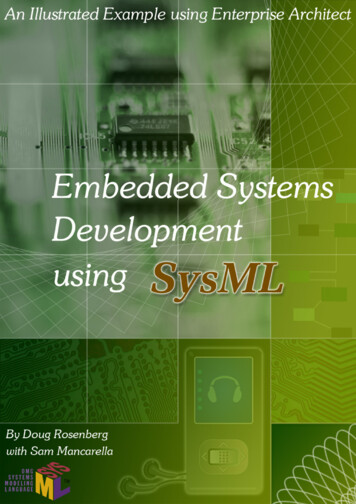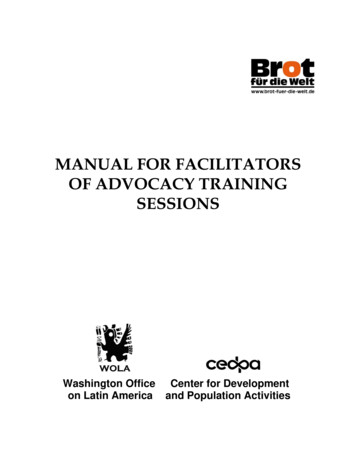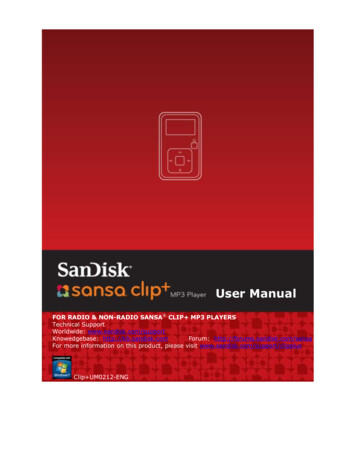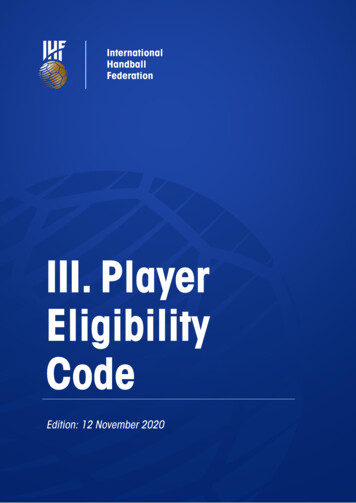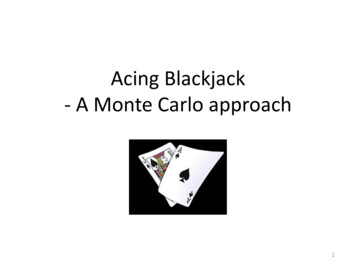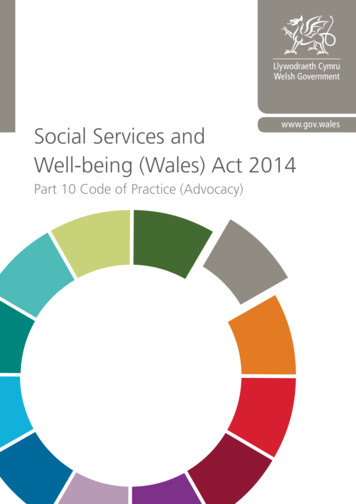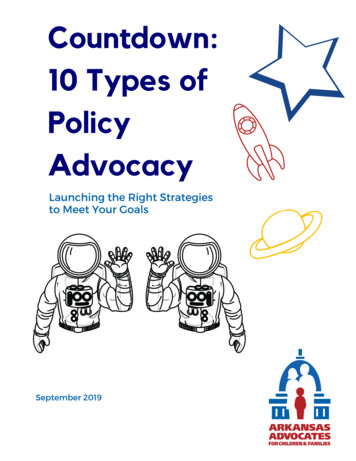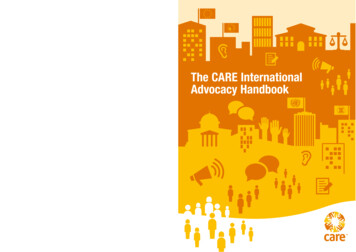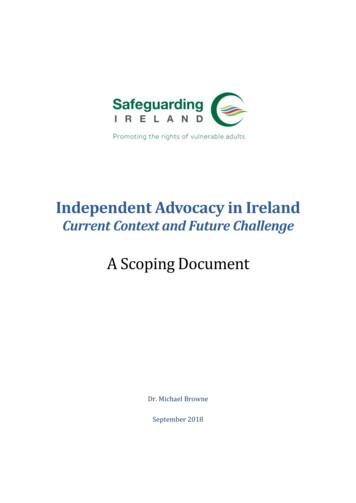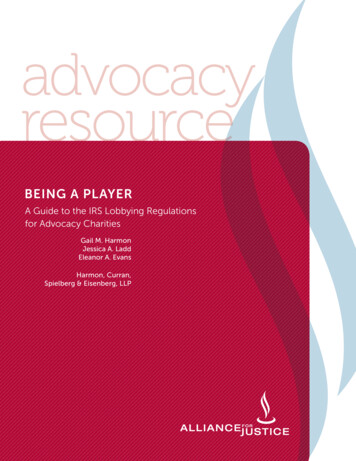
Transcription
advocacyresourceBEING A PLAYERA Guide to the IRS Lobbying Regulationsfor Advocacy CharitiesGail M. HarmonJessica A. LaddEleanor A. EvansHarmon, Curran,Spielberg & Eisenberg, LLP
BEING A PLAYERA Guide to the IRS Lobbying Regulationsfor Advocacy CharitiesA Publication by Alliance for JusticeHarmon, Curran, Spielberg & Eisenberg, LLP1726 M Street, NW, Suite 600Washington, D.C. 20036(202) 328-3500Funding for this Guide was provided by the Beldon Fund. 1991, 1995, 2000 Harmon, Curran, Spielberg & Eisenberg, LLP Copyright 2011 by Alliance for Justice. All rights reserved.ALLIANCE FOR JUSTICEBEING A PLAYERI
PrefaceNonprofits have visions for achieving real, sustainable, and systemic change. We developpolicies and programs for social justice, human rights, and a better world for us all. Butnone of our visions and none of our plans can become reality unless we become forceful andeffective advocates.Advocacy enfranchises and empowers individuals and sparks public debate and progresson the most important issues faced by our society. Advocacy connects policymakers with theideas that will move our country forward.Unfortunately, many people—including elected officials, the media, and even nonprofitstaff and directors—think that it’s inappropriate or even illegal for tax-exempt organizationsto engage in advocacy and participate in the policymaking process. This is simply not true.Being a Player is designed to encourage public charities to participate in improving andinitiating government programs and policies. One of the most effective ways to bring aboutpolicy change is by lobbying.This guide explains the Internal Revenue Service regulations on lobbying by publiccharities— an activity that Congress has declared to be an appropriate and legitimate activityfor charitable organizations. Being a Player defines lobbying, outlines the extent of permissiblelobbying, offers guidance on recordkeeping, and much more.Being a Player was prepared by Gail Harmon, Jessica Ladd, and Eleanor Evans of theWashington, DC law firm of Harmon, Curran, Spielberg & Eisenberg. Alliance for Justicestaff updated the guide in 2011.IIBEING A PLAYERALLIANCE FOR JUSTICE
About Alliance for JusticeAlliance for Justice is a national association of more than 100 organizations dedicated toadvancing justice and democracy. For over 30 years we have been leaders in the fight fora more equitable society on behalf of a broad constituency of environmental, consumer,civil and women’s rights, children’s, senior citizens’ and other groups. Alliance for Justice ispremised on the belief that all Americans have the right to secure justice in the courts and tohave our voice heard when government makes decisions that affect our lives.Alliance for Justice is the leading expert on the legal framework for nonprofit advocacyefforts, providing definitive information, resources, and technical assistance that encouragesorganizations and their funding partners to fully exercise their right to be active participantsin the democratic process. AFJ is based in Washington, D.C., with a satellite office inOakland, California. Additional information can be found at www.afj.org.Nan AronALLIANCE FOR JUSTICEBEING A PLAYERIII
ContentsIntroduction . . . . . . . . . . . . . . . . . . . . . . . . . . . . . . . . . . . . . . . . . 1I. Background Law on Lobbying Limits and Public Charities . . . . . . . . . . . . 3Standards to Measure Lobbying by Public Charities . . . . . . . . . . . . . . . . . 3To Elect or Not to Elect? . . . . . . . . . . . . . . . . . . . . . . . . . . . . . . . .3How to Elect . . . . . . . . . . . . . . . . . . . . . . . . . . . . . . . . . . . . . . . . . . .5Effect of Electing . . . . . . . . . . . . . . . . . . . . . . . . . . . . . . . . . . . .5How to Calculate Your Expenditure Limits . . . . . . . . . . . . . . . . . . . . . 6What Happens If You Exceed Your Limits? . . . . . . . . . . . . . . . . . . . . . 7II. Legislation and Lobbying: Basic Rules and Exceptions . . . . . . . . . . . . 10What is Legislation? . . . . . . . . . . . . . . . . . . . . . . . . . . . . . . . . . . . 10What is Lobbying?. . . . . . . . . . . . . . . . . . . . . . . . . . . . . . . . . . . . .11Direct Lobbying. . . . . . . . . . . . . . . . . . . . . . . . . . . . . . . . . . . .11Grass Roots Lobbying . . . . . . . . . . . . . . . . . . . . . . . . . . . . . . . .11Grass Roots Lobbying Call to Action . . . . . . . . . . . . . . . . . . . . . . 11What is Not Lobbying: The Four Basic Exceptions . . . . . . . . . . . . . . . . 13Nonpartisan Analysis, Study, or Research. . . . . . . . . . . . . . . . . . . . . 13Examinations and Discussions of Broad Social, Economic, and SimilarProblems . . . . . . . . . . . . . . . . . . . . . . . . . . . . . . . . . . . . . 15Requests for Technical Advice or Assistance . . . . . . . . . . . . . . . . . . 15“Self-Defense” Communications. . . . . . . . . . . . . . . . . . . . . . . . . 15III. Special Lobbying Rules . . . . . . . . . . . . . . . . . . . . . . . . . . . . . . . 16Membership Communications . . . . . . . . . . . . . . . . . . . . . . . . . . . . . . 16Referenda and Initiatives . . . . . . . . . . . . . . . . . . . . . . . . . . . . . . . . . . 16Paid Mass Media Advertisements . . . . . . . . . . . . . . . . . . . . . . . . . . . .17Subsequent Use in Lobbying . . . . . . . . . . . . . . . . . . . . . . . . . . . 20IVBEING A PLAYERALLIANCE FOR JUSTICE
IV. Relationships Among Organizations . . . . . . . . . . . . . . . . . . . . . . . 24Treatment of Affiliated Organizations . . . . . . . . . . . . . . . . . . . . . . . . .24Transfers to Noncharities That Lobby . . . . . . . . . . . . . . . . . . . . . . . . . 25V. Recording and Accounting For Lobbying Activities . . . . . . . . . . . . . 27Maintaining Accurate Records . . . . . . . . . . . . . . . . . . . . . . . . . . . . . 27Allocating Expenditures. . . . . . . . . . . . . . . . . . . . . . . . . . . . . . . . . 28VI. Seeking Funding from Private Foundations. . . . . . . . . . . . . . . . . . . 34Earmarking Prohibited . . . . . . . . . . . . . . . . . . . . . . . . . . . . . . . 34General Support Grants . . . . . . . . . . . . . . . . . . . . . . . . . . . . . . 34Specific Project Grants . . . . . . . . . . . . . . . . . . . . . . . . . . . . . . . . . 34Conclusion. . . . . . . . . . . . . . . . . . . . . . . . . . . . . . . . . . . . . . . . . 35Appendix A . . . . . . . . . . . . . . . . . . . . . . . . . . . . . . . . . . . . . . . . . 36Appendix B . . . . . . . . . . . . . . . . . . . . . . . . . . . . . . . . . . . . . . . . . 40Appendix C. . . . . . . . . . . . . . . . . . . . . . . . . . . . . . . . . . . . . . . . . 41Appendix D. . . . . . . . . . . . . . . . . . . . . . . . . . . . . . . . . . . . . . . . . 42ALLIANCE FOR JUSTICEBEING A PLAYERV
IntroductionThis Guide has been created to help advocacy-oriented charities understand and use theTreasury Department regulations regarding lobbying activities by public charities. Althoughmany charities may not be aware of it, charities are clearly entitled to engage in lobbyingactivities. Congress reaffirmed this right when it enacted the 1976 legislation that is the basisfor the regulations discussed in this Guide. Sections of the Guide explain the basic law onlobbying activity, how to determine your organization’s lobbying expenditure limits and, mostimportantly, how to determine when you are lobbying and when you are not.These regulations are effective for tax years beginning after August 31, 1990.Although the Guide directly addresses the law on this topic, it is not intended as legaladvice. Rather, it is our hope that the Guide will provide you with enough information andclarification to help you navigate the regulations’ varied provisions as they apply to the dayto-day management of a public charity (the Guide uses the terms “501(c)(3) organization” and“public charity” interchangeably). In order to use this Guide successfully, you should readthe entire booklet to gain a full understanding of the regulations. Ultimately, we hope thatthis knowledge will enable you to make informed choices as you structure your lobbyingactivities, to be aware of potential legal questions and problems associated with these activities,and to know when to consult legal counsel should such questions and problems arise.These regulations areeffective for tax yearsbeginning after August31, 1990.In addition, we hope that the Guide will be useful to both public charities and privatefoundations. For public charities, the only type of exempt organization eligible to elect tofollow the expenditure test, the Guide explains the lobbying limits and which expensescount as lobbying. For private foundations, which are prohibited from lobbying or makinggrants earmarked for lobbying purposes, the Guide explains how to determine whetheradvocacy activities count as lobbying and how to make grants to charities which lobby.Public charities and private foundations are both types of 501(c)(3) organizations.However, while public charities are supported by a variety of financial sources, privatefoundations are generally funded from a single source (usually an individual, a familyor a corporation). In addition, private foundations usually receive continuing funding frominvestment income, rather than contributions, and generally make grants to other organizationsfor charitable purposes instead of conducting their own programs. Congress believes that thefact that private foundations are funded by a single source creates potential for abuse; thereforeprivate foundations are subject to more stringent rules (including additional penalties andrestrictions on their lobbying activities) than are public charities.ALLIANCE FOR JUSTICEBEING A PLAYER1
A Word About the Examples Used in this GuideIn order for the examples used in the Guide to build logically upon each other, we havecreated the fictional Dragon Lovers’ Association for Research and Education, Inc., or DAREfor short. You will need to know the following background information about DARE:By providing legal supportto nonprofits to participateDARE is a charitable and educational organization tax-exempt under section 501(c)(3) of theInternal Revenue Code and has a fiscal year that coincides with the calendar year. DARE strivesto educate members of the general public regarding the endangered North American Dragonand, ultimately, to protect the dragon from extinction. Among its various activities, DAREresearches the dragon and makes research results available to the public through lectures,discussion groups and publications. DARE also publishes the DARE Quarterly magazine, andoperates the Adopt-A-Dragon program to raise funds and help ensure protection of individualmembers of the species. Most importantly, DARE engages in lobbying activities aimed atprotecting the dragon and its habitat and, therefore, has elected to be subject to the section501(h) expenditure test as it is described in later sections of this Guide.in the political process,Alliance for Justice seeks toenhance their participationin public policy debates.2BEING A PLAYERALLIANCE FOR JUSTICE
I. Background Law on Lobbying Limits andPublic CharitiesA. Standards to Measure Lobbying by Public CharitiesThe Internal Revenue Code limits the amount of lobbying activities in which section501(c)(3) public charities may engage. Charities may choose one of two standards by whichtheir compliance will be measured. One standard, known as the “insubstantial part test,”requires that “no substantial part of a charity’s activities be carrying on propaganda orotherwise attempting to influence legislation.” If charities exceed this vague standard, theyrisk losing their exemptions altogether. Furthermore, when the IRS examines the lobbyingactivities of non-electing charities, it does not limit itself to determining the amounts spentfor lobbying but instead will examine a host of “softer” factors such as the organization’s goalsand success in achieving them as well as the amount of time and energy devoted to legislativematters by the charity’s board and volunteers, regardless of cost.The other standard, known as the “section 501(h) expenditure test,” sets specific dollarlimits, calculated as a percentage of a charity’s total exempt purpose expenditures (i.e., 20percent of the first 500,000 ), on the amount public charities electing to follow thismethod may spend to influence legislation without incurring penalty taxes or losing theirexempt status. Congress enacted sections 501(h) and 4911 in 1976 to provide the option of anobjective standard rather than the vague insubstantial part test. Unlike the insubstantial part test,the expenditure test imposes no limit on lobbying activities that do not require expenditures,such as unreimbursed lobbying activities conducted by bona fide volunteers. A charity wishingto be subject to the expenditure test must take the affirmative step of filing an election;charities that do not file an election are subject to the insubstantial part standard.If charities exceed thevague, insubstantial partstandard, they risklosing their exemptionsaltogether.B. To Elect or Not to Elect?Federal regulations define and clarify the application of the expenditure test to electing publiccharities. For a variety of reasons, many public charities will now find it more advantageous toelect rather than to be governed by the vaguer provisions of the insubstantial part standard.Ability to PlanThe regulations contain a wealth of planning information, so if you are an electingpublic charity, you will find it easier to determine the amount you are allowed to spend onlobbying and how to spend this money wisely. In particular, the definitions of various kindsof lobbying communications enable you to control whether you are lobbying or not bystructuring particular communications to fall inside or outside the definitions, as you wish.Although one might argue that these definitions should apply to non-electing charities aswell as to electing charities, the IRS has issued no authoritative guidance on this point. Therefore,organizations subject to the insubstantial part standard should use caution in relying on the newdefinitions for planning purposes.Larger LimitsAlthough some very large organizations may benefit from the insubstantial part test,it is generally thought that most organizations will have higher lobbying limits under theexpenditure test (only organizations with exempt purpose expenditures in excess of 17million will reach the 1 million ceiling). Not only does the expenditure test’s percentagecalculation generally allow charities higher dollar limits than does the insubstantial part test,but fewer items count toward the exhaustion of those limits. While the limits of electingorganizations are determined purely on the basis of lobbying expenditures, the insubstantialpart standard for nonelecting charities applies to all “activities” regardless of whetherALLIANCE FOR JUSTICEBEING A PLAYER3
they generate any expenditures or not. In practical terms, this means that an organizationgoverned by the insubstantial part test could spend practically no money on lobbying butstill surpass its lobbying limit if it had substantial volunteer lobbying activities.Less Likely to Lose ExemptionIn addition, electing organizations probably have less chance of losing their tax exemptionthan do their nonelecting counterparts. This is because the IRS considers the electingorganization’s lobbying and grass roots expenditures as a moving average over a four-year periodand can revoke the organization’s exemption only if it exceeds either limit by 50 percent. Incontrast, the nonelecting group could lose its exemption on the basis of substantial lobbyingwithin a single tax year.No Personal Penalty TaxesThe regulations containa wealth of planninginformation, so if youare an electing publiccharity, you will find iteasier to determine theamount you are allowedto spend on lobbying andhow to spend it wisely.Even where an electing organization exceeds its lobbying expenditure limits and must paythe applicable penalty taxes for the excess, only the organization is liable. In a non-electingorganization, however, individual managers may be held personally liable for the penalty taxes iftheir actions may be characterized as willful or not due to reasonable cause.Myth Versus FactAudit RiskContrary to popular belief, the IRS has publicly stated that there is no increased risk of anIRS audit if an organization files an election. In fact, a recent addition to the IRS agents’ manualexpresses the belief that it is nonelecting organizations that are most likely to have exceededtheir lobbying limits.Extra Record-KeepingMoreover, filing an election may actually reduce the record- keeping obligations on a publiccharity. All public charities with receipts greater than 25,000 per year are already required tofile a Form 990 and Schedule C (organizations with receipts less than 25,000 per year mustfile Form 990-N).Part VI-B of the Form 990’s Schedule C requires lobbying nonelecting organizations tolist their lobbying expenditures in each of the following categories: paid staff; advertisements;mailings to members, legislators or the public; grants to other organizations for lobbyingpurposes; direct contact with legislators, their staffs, government officials, or legislative bodies;and rallies, demonstrations, seminars, conventions, speeches, and lectures. In addition, suchorganizations must attach a detailed description of lobbying activities, including the useof volunteers.Other RestrictionsEven though federal and some local laws prohibit charities from using government fundsfor lobbying activities (e.g., rules in OMB Circular A-122), charities are entitled to use otherfunds for lobbying activities. Similarly, rules requiring registration of lobbyists and reporting oflobbying activities should not deter charities from exercising their legal right to lobby.Reversible DecisionFinally, if you are not already convinced of the desirability of electing the expendituretest, you should be aware that the election is reversible for future years. It may be voluntarilyrevoked at any time in essentially the same manner as it was originally filed.4BEING A PLAYERALLIANCE FOR JUSTICE
Final Word of CautionDespite the relative advantages of electing for most organizations, there is still a small groupof lobbying organizations that may be better off with the vaguer insubstantial part standardinstead of the expenditures calculation. For instance, universities, hospitals and large humanservices organizations which may combine large budgets and small lobbying agendas maywant to avoid electing. In addition, the special rules governing “affiliated” organizations willcomplicate the decision as to whether to elect. Note, however, that for some organizations, thebest approach may be to “un-affiliate” rather than to be subject to the insubstantial part test.Those organizations with exempt purpose expenditures greater than 17 million per year willbe limited to a 1 million cap on lobbying expenditures under the expenditure test but mightbe allowed to do more lobbying under the insubstantial part test. Finally, some organizationswhose lobbying is mostly or exclusively “grass roots lobbying” (a term defined in Part II ofthis book) may be able to engage in more grass roots lobbying under the insubstantial partstandard than under the expenditure standard.Contrary to popularbelief the IRS has publiclystated that there is noincreased risk of an IRSaudit if an organizationfiles an election.C. How to ElectOnce your organization has decided to elect to be governed by the expenditure test, youmust file a Form 5768, “Election/Revocation of Election by an Eligible 501(c)(3) Organizationto Make Expenditures to Influence Legislation” (reproduced in the margin and in AppendixB). The organization simply supplies its name, address, and the first tax year to which itwants the election to apply and then has the form signed by an authorized officer, usuallythe president or treasurer. Generally, the election will apply to the designated year and to allsubsequent tax years (until such time as the election is revoked). Revocation of election ismade by filing another Form 5768, but it becomes effectiveonly prospectively, unlike the original election which isretroactive to the beginning of the tax year in which it isfiled. An organization may then re-elect if it wants to, but there-election cannot become effective until at least one tax yearafter the year in which a voluntary revocation is filed.Example:DARE, which uses the calendar year as its fiscal year, filesan election on July 31, 2010 designating 2010 as the firsttaxable year to which the election should apply. The electionis effective for the tax year beginning January 1, 2010, eventhough it was filed at a later date. If DARE decides in 2011that it would be better off with the insubstantial part testinstead and files a revocation of election on July 31, 2011,the revocation would not become effective until January1, 2012. Finally, if DARE changes its decision again inearly 2012 and wants to re-elect, it may file a new electionduring 2012, but the new election would not apply until taxyear 2013.D. Effect of ElectingAssuming that you have decided to file an election, yourorganization will be subject to two lobbying expenditure limits.The first restricts the total amount of lobbying expendituresan electing public charity may make, and the second controlsa subset of those expenditures, known as “grass roots”lobbying expenditures. Reflecting these two expenditureALLIANCE FOR JUSTICEBEING A PLAYER5
limits, attempts to influence legislation are divided into two categories: “direct lobbyingcommunications” and “grass roots lobbying communications.”How to Calculate Your Expenditure LimitsIn calculating yourlobbying limits, note thatthe grass roots limit isone quarter of the totallimit, regardless of howmuch your organizationactually spends ondirect lobbying.The first step in determining dollar figures for your lobbying expenditure limits is tocalculate what your organization’s “exempt purpose expenditures” are for the yearin question. Broadly defined, exempt purpose expenditures include all the amounts yourorganization pays or incurs in furtherance of its exempt purposes, including expendituresfor lobbying, depreciation and amortization on its assets, controlled grants (i.e., pursuantto an agreement that the grant money may only be used for certain non-lobbying purposes),and costs of most in-house fund-raising that is not conducted by a separate fund-raisingunit. Exempt purpose expenditures do not include: payments of tax on unrelated businessincome; expenses associated with attempts to produce unrelated business income; capitalaccount expenses such as amounts paid out for new buildings or permanent improvementsto increase the value of any property or real estate; and expenses for a separate fund-raising unit(generally, two or more individuals, the majority of whose time is spent on fund-raising) oran outside fund-raising consultant. Once you have determined a figure for your exempt purposeexpenditures, you simply apply the following formulae to them to yield the two lobbyingexpenditure limits:A. Total Lobbying Expenditures Limit 20% of the first 500,000 of exempt purpose expenditures 15% of the next 500,000 of exempt purpose expenditures 10% of the third 500,000 of exempt purpose expenditures 5% of the remaining exempt purpose expenditures.In no case may the total lobbying expenditures limit begreater than 1 million.B. Grass Roots Lobbying Expenditures Limit 25% of AIn calculating your specific lobbying limits, note thatthe grass roots limit is one quarter of the total lobbyinglimit, regardless of how much your organization actuallyspends on direct lobbying. So, if an organization’s total limitis 100,000, its grass roots limit is 25,000, even if theorganization spends no money at all on direct lobbying.A chart calculating lobbying expenditure limits for variouslevels of exempt purposes expenditures is located inAppendix C.Example:Suppose that DARE has no separate fund-raising unit.DARE’s 2010 expenditures are as follows:6BEING A PLAYERALLIANCE FOR JUSTICE
DARE’s 2010 ExpendituresResearch Activities: 270,000*Educational Programs: 210,000*Controlled Grants for Exempt Purposes: 30,000*Lobbying Activities: 122,000*DARE Quarterly:generating advertising:UBIT:1all other expenses: 6,000 4,000 17,000*Adopt-A-Dragon Program: 10,000*In-House Fund-Raising Expenses: 5,000*Outside Fund-Raising Consultant: 3,000Overhead Allocable to EPE:2 120,000*Non-EPE Overhead: 30,000TOTAL EXPENDITURES 827,000TOTAL EPE:3 784,0001Unrelated Business Income Tax.2Exempt Purpose Expenditures. Note that you must allocate a reasonable portion of overheadexpenses to correspond to your other nonexempt purpose expenditures.3Exempt purpose expenditures are marked with an asterisk (*); all other expenditures arenonexempt purpose expenditures.Calculations to determine DARE’s lobbying limits:Given the above figures, DARE would have a total lobbying limit of :20% of 500,000 15% of 284,000 142,600and a grass roots lobbying limit of : 25% of 142,600 35,650.What Happens If You Exceed Your Limits?If an electing charity exceeds its expenditure limits for any given year, it will be requiredto pay an excise tax of one quarter of the excess expenditures. If the charity exceeds both itstotal lobbying expenditures limit and its grass roots lobbying expenditures limit, it will be requiredto pay one quarter of whichever excess amount is greater.Example:Taking DARE’s lobbying limits as calculated in the last section, suppose that DAREspends 173,000 on lobbying expenses in 2010, 30,000 of which are expenses for grass rootslobbying. Then DARE owes 25 percent of 30,400 (the excess), or 7,600, in excise taxes.ALLIANCE FOR JUSTICEBEING A PLAYER7
Planning TipIn order to monitor your organization’s lobbying expenditures adequately, you shouldexamine your proposed budget at the beginning of each taxable year, analyze yourbudgeted expenses to determine your projected exempt purpose expenditures, andthen apply the limits calculations to arrive at projected dollar limits for your lobbyingexpenditures. Based on your projected expenditures and limits, you should then keepaccurate records regarding your actual exempt purpose and lobbying expenditures,and periodically compare those figures to your projections for the year. If you keeprecords in this manner, you will be able to make adjustments to your projections asthe year progresses and thereby avoid any unforeseen excesses and consequent taxesat year’s end.A charity that violates the expenditure limits only risks losing its exemption if it exceedseither lobbying limit (total or grass roots) by more than 50 percent, generally calculated usinga four- year moving average. Charities whose exemptions are revoked are also subject to theexcise tax on their excess lobbying expenditures.Example:The following chart illustrates a calculation of the excise tax and provides information needed todetermine the four-year average as applied to DARE’s lobbying activities between 2007 and 2010.For purposes of this example, assume that DARE’s first taxable year as a 501(c)(3) occurred in 1980and that DARE had no grass roots lobbying activities between 2007 and 2010.DARE Four-Year Moving Average 2007–2010Year1Actual EPETotal LobbyingLimit2Actual LobbyingExpensesExcise Tax Due25% x [E-A] 10,0002007 700,000 130,000 [A] 170,000 [E]2008 500,000 100,000 [B] 120,000 [F]25% x [F-B] 5,0002009 800,000 145,000 [C] 150,000 [G]25% x [GC] 1,2502010 750,000 137,500 [D] 100,000 [H]H D therefore,no tax due1The moving average calculation is applied by analyzing figures for any taxable year in whichthe expenditure test is in effect (the “deterrnintation year”) and the three preceding years (“baseyears”), provided that the organization’s first taxable year as a 501(c) (3) does not count as either adetermination or a base year.2Termed the “Lobbying Nontaxable Amount.”Calculations to determine if exempt status is jeopardized:150% of Total 4-Year Limit 150% of [A B C D] 768,750Total Lobbying Expenses for 4 Years E F G H 540,000Total Actual Expenses 150% Total Limits ( 540,000 768,750), therefore, no loss ofexemption.8BEING A PLAYERALLIANCE FOR JUSTICE
Planning TipJust as yearly budgeting and monitoring of lobbying expenditures can help you toavoid excessive lobbying expenditures and the resulting excise tax, the four-yearmoving average enables you to budget and monitor your lobbying acitivites fromyear to year. In addition, you can use the average to correct excesses in past years bybudgeting less lobbying in the future.ALLIANCE FOR JUSTICEBEING A PLAYER9
II. Legislation and Lobbying: Basic Rules andExceptionsIn general, lobbying consists of communications that are intended to influence specificlegislation. Therefore, it is important to develop an understanding of what constituteslegislation before approaching the question of what is and what is not lobbying.A. What Is Legislation?In general,lobbying consists ofcommunications that areintended to influencespecific legislation.The regulations define legislation as action by a legislative body, including the“introduction, amendment, enactment, defeat or repeal of Acts, bills, resolutions, or similaritems.” Legislation includes actions by Congress, a state legislature, a similar local legislativebody, or any actions by the general public in a referendum question, initiative petition, orproposed constitutional amendment. In addition, the regulations include Senate confirmationof executive and judicial branch nominees and proposed treaties requiring Senate approval(from the time that the President’s representative begins to negotiate its position wit
created the fictional Dragon Lovers' Association for Research and Education, Inc., or DARE for short. You will need to know the following background information about DARE: DARE is a charitable and educational organization tax-exempt under section 501(c)(3) of the Internal Revenue Code and has a fiscal year that coincides with the calendar .
